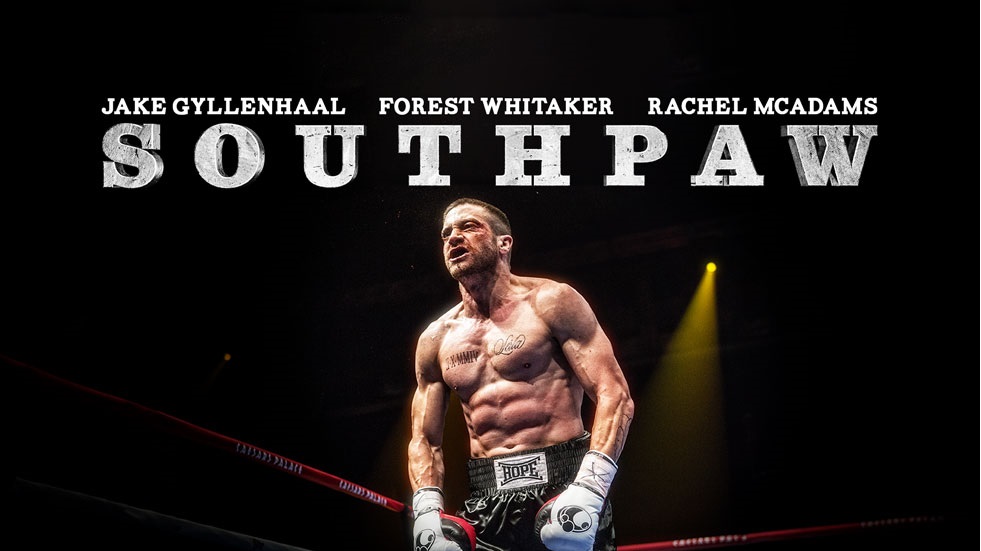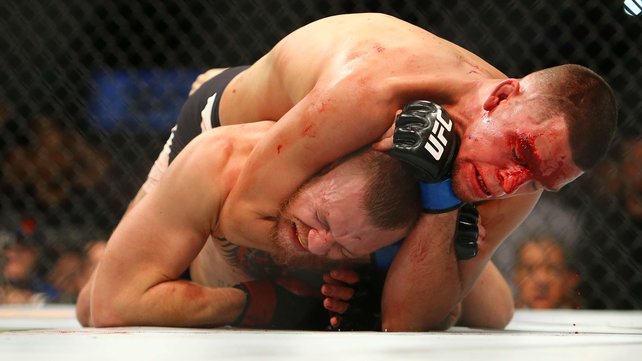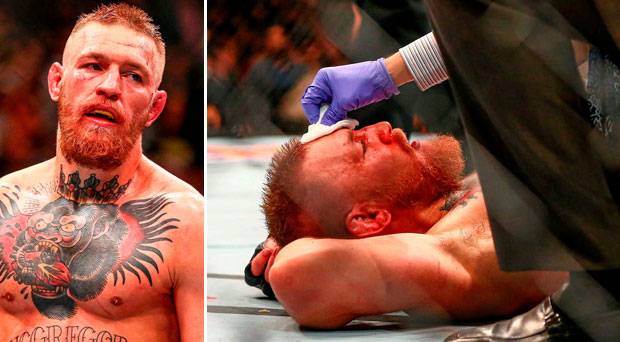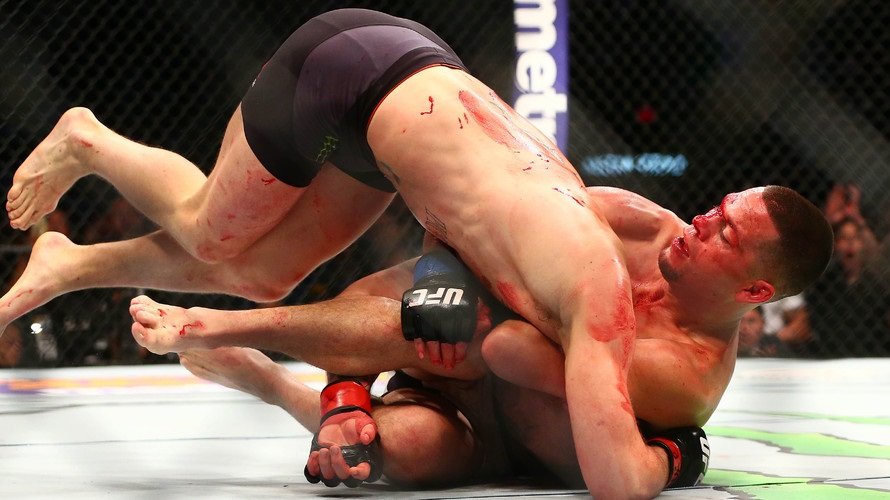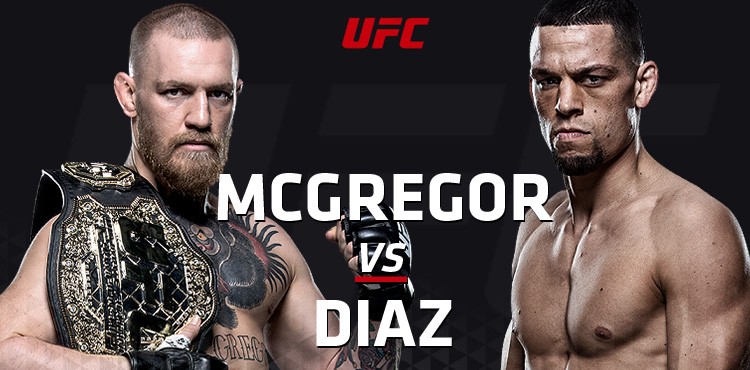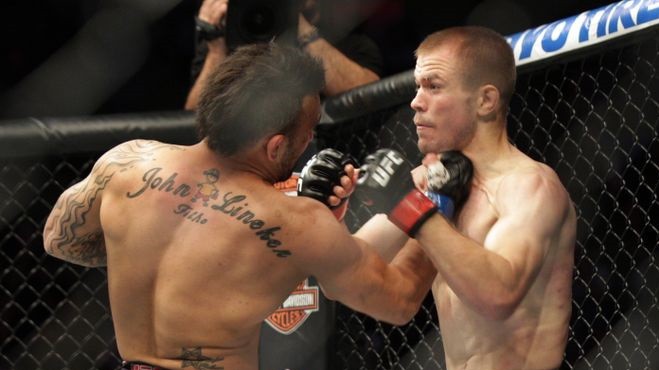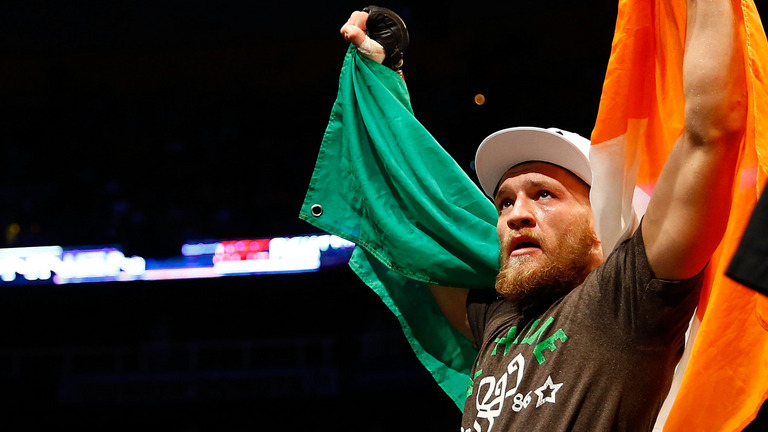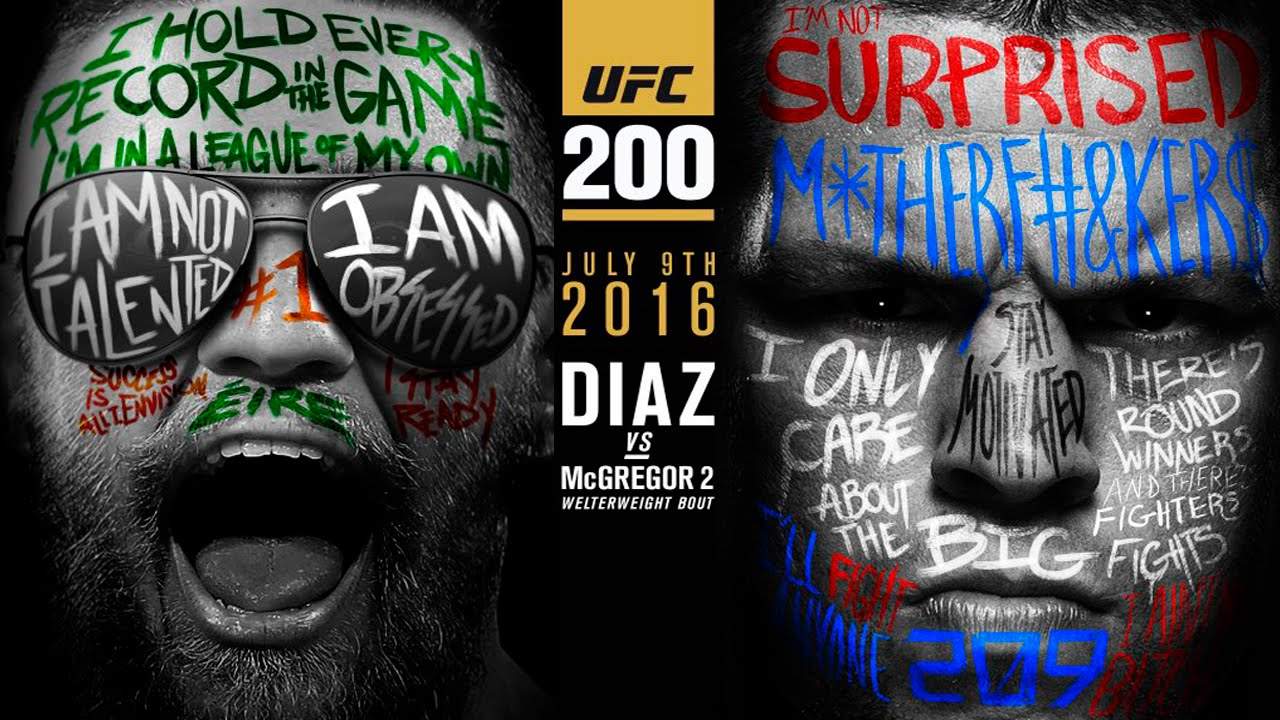
Earlier this week I broke down the first match up between Nate Diaz and Conor McGregor. It cleared up some misconceptions, and now it’s time to ask some questions.
Can Conor Attack The Lead Leg?
Nate is vulnerable to specifically two types of fighters: those who can hack his lead leg and those who can take him down and avoid his submissions.
Regardless of what Conor says and his fans believe, the latter isn’t going to happen.
Every fighter can throw a good leg kick if you asked them to in the gym. But integrating it into a fighter’s existing style is no easy task. Conor (like any boxer) does his best work with both feet on the ground, where he can smoothly transition his weight for combinations and counter shots. IF Conor can integrate leg kicks into his game, it’s a question of whether it is worth detracting from his considerable strengths to do so.
Nate also got Conor to the ground with the first kick he caught. Certainly it’s harder to catch a leg kick, but if Conor gets on his back again he can’t count on sweeping Nate like their first fight. Nate has also adopted a kickboxing style defense for leg kicks as shown against Michael Johnson, where he would simply pull his leg back until the kick passed and then step back in.
The most promising of Conor’s options is the low teep, which buckled Nate’s knee when he landed it.

F**k yo knee bruh
Had that been any lower, it could have caused some serious damage. Low teeps are not going to slow Nate down as much as pulverizing his thighs would, but tendon damage can completely change the nature of the fight (as Conor knows from first-hand experience). Jon Jones uses it to keep his opponents at range, but Conor used it with a little skip to close distance.
Again, Nate’s advantage is his adaptability and the teep will have a limited window of effect. But if you can rip an ACL . . .
How Does Nate’s Chin Fare at 170 lbs?
Both the Diaz brothers are tough, but whereas Nick gets by on his bulldog jaw Nate relies on his slick defense.
If you can hit Nate clean, he will be hurt; Rafael Dos Anjos, Benson Henderson and Josh Thomson all proved this. But it’s that hitting him clean part that is difficult.
Spinning his head to roll with a punch, shoulder rolls, and leans all allow Nate to absorb a portion of the blow. A punch may only have a fraction of the power once it skates off his shoulder, or hits his head at a steep angle (a trigonometry lesson that I won’t punish you with).

Pain is your god now
Plus, a punch that lands with the same amount of force straight on or at an angle is delivering impact in different ways. A punch that hits at a perfect 90 degrees will transmit its force to the brain, while at a deviated angle it’s more likely to damage the soft tissue.
But we’ve never seen Nate fight a true welterweight striker before. In four welterweight bouts he beat Rory Markham and Marcus Davis (neither of whom are elite strikers) and lost decisions to Dong Hyun Kim and Rory MacDonald (both enormous grapplers). We’ve never seen his chin tested at that weight, as he’d already gone down to lightweight by the time Lawler, Hendricks and Woodley arrived in the division.
While Conor’s bulked physique has some drawbacks, there’s no denying that his already hellacious left hand is about to have some extra salt on it.
Nate essentially stood in front of Conor, rolling with his left and countering it in the first fight . . . but can he do it at welterweight? Hypothetically speaking, taking 30% of the power off a 1000 Newton punch and taking 30% off a 1400 Newton punch are two different stories.

Will that slick, last minute roll and sway work at 170?
Weight changes are so funky and impossible to predict. For every Dustin Poirier and Anthony Johnson who experience a dramatic increase in strength, power and endurance by moving up there is a Rich Franklin or BJ Penn who find themselves healthier but undersized and underpowered for the new division.
Perhaps Nate can absorb the damage better at his new weight, or maybe his capacity will remain static and he’ll find himself concussed by a Conor left hand.
We don’t know, but we need to watch for it.
Can Conor Avoid the Clinch?
I’d worry more about the clinch than the ground if I were Conor.
Nate has never been a wrestler, opting for gentlemanly etiquette by letting his opponents go to the ground first either with a takedown attempt or keeling over from having their skulls rattled. But the clinch is something Nate readily initiates and somewhere that Conor will drown.
The clinch is very taxing, especially for the fighter with their back to the fence. It requires almost constant energy expenditure to manipulate the opponent’s limbs, shift their weight and land blows. Rick Story has used this position to drain the gas tanks of far more talented fighters like Thiago Alves and Gunnar Nelson and come out with wins.
Nate’s clinch especially brutal because, like everything else he does, its energy efficient. Against Conor he repeatedly pulled his arm away to sink clean knees to the solar plexus, and as soon he moved his arm to guard his stomach Nate would begin hitting him with short punches to the head and body
It’s something that will happened every time they clinch whether it’s the first or fifth round.
Conor’s effective range is very limited in this match up.
Too far away and he can’t connect while Nate’s straight punches will land at his maximum range, where they crack with deceptive power. Too close and he will be clinched, where Nate’s gas tank will outlast his by a country mile. His own clinch has proven inadequate; on offense his knees and punches were blocked with ease and on defense he was expending too much energy for minimal results.
He definitely noticed this, as there were several times when Nate moved forward to clinch and Conor either moved or swatted him away. But that threw off his rhythm as well, and it doesn’t bode well if Nate can stop his offense simply by stepping in.
Who Counters Who?
In terms of their counter game, Conor and Nate have developed in opposite directions. Conor was a great counter fighter that started leading, while Nate tempered traditional Diaz aggression to become more of a strategist.
It was Conor who started countering first against Nate, punishing jabs and lead hooks with vicious straights and snapping his head to the lights with uppercuts whenever he leaned. But by the second round the tables had completely reversed. It was Nate who was baiting the straight and punishing it with hooks, drawing slips from Conor so he’d eat jabs and crosses cleanly.
With a full camp, I doubt Nate will eat so many lefts. At the same time, Conor will (hopefully) keep his hands higher at distance lest his slips get read.
Nate’s reach advantage puts the counter game in his court, but he can be baited.
Josh Thomson delivered the only definitive knockout loss of a Diaz brother by turning his tendencies against him. Because of Nate’s side on stance, he couldn’t stop Thomson circling past his lead hand. He forced Nate to chase, picking shots and frustrating him. Add that Thomson is a good clinch wrestler, and Nate starting to lose his cool.
The real beauty was the head kicks that Thomson kept landing clean on the defensively savvy Diaz. Body kicks are devastating for two reasons. First, the body isn’t mobile so most of Nate’s usual defensive options don’t apply. Second, the leg is so sturdy and powerful that just blocking is asking for injury (ask Jerome Le Banner how that feels).
So Nate read a body kick and leaned with both arms ready to divert the shot, only to eat a shin to the forehead that more or less ended the fight.

Pulling this kind of stuff off is easier said than done.
Since then Nate has resisted chasing and, unlike Nick, is great at adapting on the fly. And it needs to be repeated that Nate had to lean into multiple clean headkicks before being finished, and even then he wasn’t completely out. Plus the kick Nate caught to put Conor down in their first round was, in fact, a body kick.
Whether Conor has the power or the gas tank to punish Nate 2.0 in such a manner has yet to be seen.
But it’s not far-fetched to think that Conor could fake a straight, wait for Nate to come with a lead hook and then blast him with a real straight over the top aka the Robbie Lawler. As the first guy to punish Nate multiple times with an uppercut for leaning, he could put some more power behind it to increase the damage.
For now, it seems Nate’s fight to lose. The fact is that the rematch boils down to whether Conor can adapt to the natural advantages that Nate has. And even those advantages may not be enough since Nate can endure, learn and then counter as the fight goes on.
But who knows. Michael Bisping and Tyron Woodley slept fighters we didn’t dream they had a chance against, and the same may happened tomorrow.








